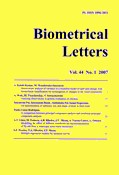
Biometrical Letters Vol. 44(1), 2007, pp. 71-81


Several methods have been developed in order to study lactation curves. However, the lactation curves are often not well adjusted since several factors affect milk production. The usual model used to describe a lactation curve is Wood's Model, which generally uses a logarithmic transformation of an incomplete gamma curve to obtain least squares estimates of three constants: a - a scaling factor associated with average daily yield; b - associated with pre-peak curvature; and c - associated with post-peak curvature (Wood, 1976). Some disadvantages of Wood's model are strongly connected with overestimation of milk production at the beginning of lactation, with underestimation of the lactation peak; the self-correlated residuals and highly correlated parameter estimates (Scott et al, 1996). Fleischmann's Method is usually used to estimate total milk production. This method generally overestimates actual yields up to peak lactation as well as yield during the period following the last measurement, but underestimates yields for other periods (Norman et al, 1999). The total milk yield estimate according to this method considers a constant daily milk production between two records and equal to the mean of these two records, which does not describe the true variation of milk secretion during lactation. The mentioned disadvantages led us to consider the milk curve concept as a graphical representation of milk production described by mathematical models.In our work we considered a new approach using polynomial regression, one for each group. Polynomial curves were adjusted to daily milk records for each group and the respective hypo-graphic area was calculated to estimate total yields. An ANOVA to the comparison of these total yields was carried out and the Scheffé multiple comparison method was applied.This approach greatly increases the power of the test, enabling work with smaller experiments, the reason for this increase being the replacement of classical replicates by time replicates, leading to a great increase in

multiple regression, lactation curve, ewe's milk production

